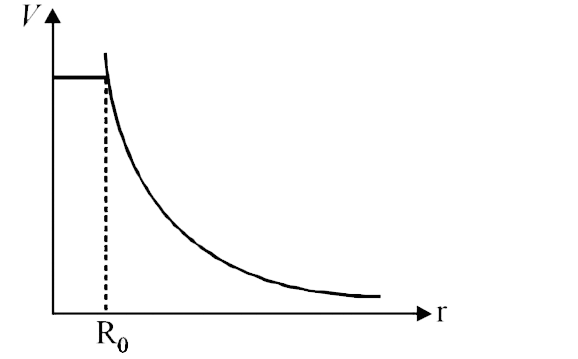The Bohr model for the H-atom relies on the Coulomb's law of electrostatics . Coulomb's law has not directly been varified for very short distances of the order of angstroms. Suppos-ing Coulomb's law between two oppsite charge is modified to
Calculate in such a case , the ground state enenergy of H-atom , if
Considering the case, when
Let
where,
The electrostatic force of attraction between positively charged nucleus and negatively charged electrons (Columbian force) provides necessary centripetal force.
or
[Applying Bohr's second postulates]
solving this for r,we get
where, is radius of nth orbit of electron,
For and substituting the values of constant, we get
This is the radius of orbit of electron in ground state of hydrogen atom.
For
[This is the speed of electron in ground state]
till , [This is the PE of electron in ground state at ]
PE from to
[This is PE of electron in ground state at to ]
Total energy is
This is the required TE of electron in ground state.
Topper's Solved these Questions
Similar Questions
The Bohr model for the H-atom relies on the Coulomb's law of electrostatics . Coulomb's law has not directly been varified for very short distances of the order of angstroms. Suppos-ing Coulomb's law between two oppsite charge +q1,−q2 is modified to ∣∣→F∣∣=q1q2(4πε0)r21r2,r≥R0
=q1q2(4πε0)r21R20(R0r)ε,r≤R0
Calculate in such a case , the ground state enenergy of H-atom , if ε=0.1,R0=1ÅView Solution41.Self energy of conducting sphere of radius r carrying charge is (1) Q28πε0(r) (2) Q24πε0(r) (3) Q26πε0(r) (4) Q22πε0(r)
View Solution
Knowledge Check
- Question 1 - Select One
The electrostatic force between two point charges q1 and q2 at separation r is given by F=k.q1q2r2. The constant k
ADepends upon system of units onlyBDepends upon medium between the chargesCDepends on both 1 and 2DIs independent of both 1 and 2 - Question 2 - Select One or More
A spherical symmetric charge system is centered at origin. Given, Electric potential
V=Q4πε0R0(r≤R0), V=Q4πε0r(r>R0)
 A(a) Within r=2R0 total enclosed net charge is QB(b) Electric field is discontinued at r=R0C(c) Charge is only present at r=R0D(d) Electrostatic energy is zero for r<R0
A(a) Within r=2R0 total enclosed net charge is QB(b) Electric field is discontinued at r=R0C(c) Charge is only present at r=R0D(d) Electrostatic energy is zero for r<R0
If Coulomb's law involved 1r3 (instead of 1r2), would Gauss's law still be true?
View SolutionThe vector form of Coulomb's law is (A) →F=14πε0⋅q1q2|→r|3→r (B) →F=14πε0⋅q1q2r3 (C) →F=14πε0⋅q1q2r2→r (D) →F=14πε0⋅q1q2r→r
View SolutionThe vector form of Coulomb's law is (A) →F=14πε0⋅q1q2|→r|3→r (B) →F=14πε0⋅q1q2|→r|3 (C) →F=14πε0⋅q1q2r2→r (D) →F=14πε0⋅q1q2r→r
View SolutionEvaluate ∫r2r1(r−ηq0qr2)dr
View SolutionA charge q1 is placed at the centre of a spherical conducting shell of radius "R" .Conducting shell has a total charge q2 .Electrostatic potential energy of the system is (A) q21+2q1q28πɛ0R (B)q22+2q1q28πɛ0R (C) q21+q1q28πɛ0R (D) q22+q1q28πɛ0R
View SolutionWrite an expression for potential at a point P −→(r) due to two point charges q1andq2 at →r1and→r2 respectivley.
View Solution

